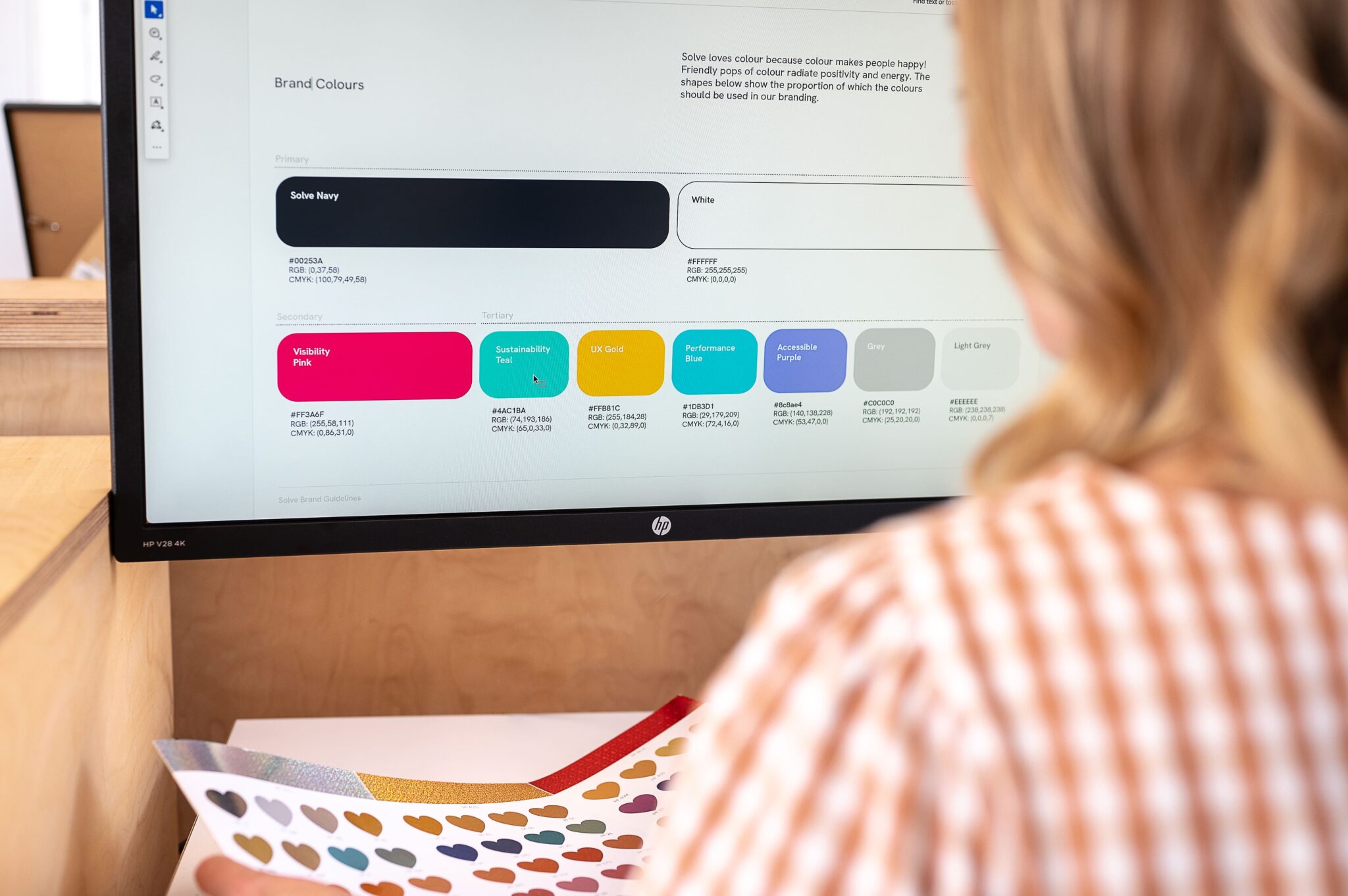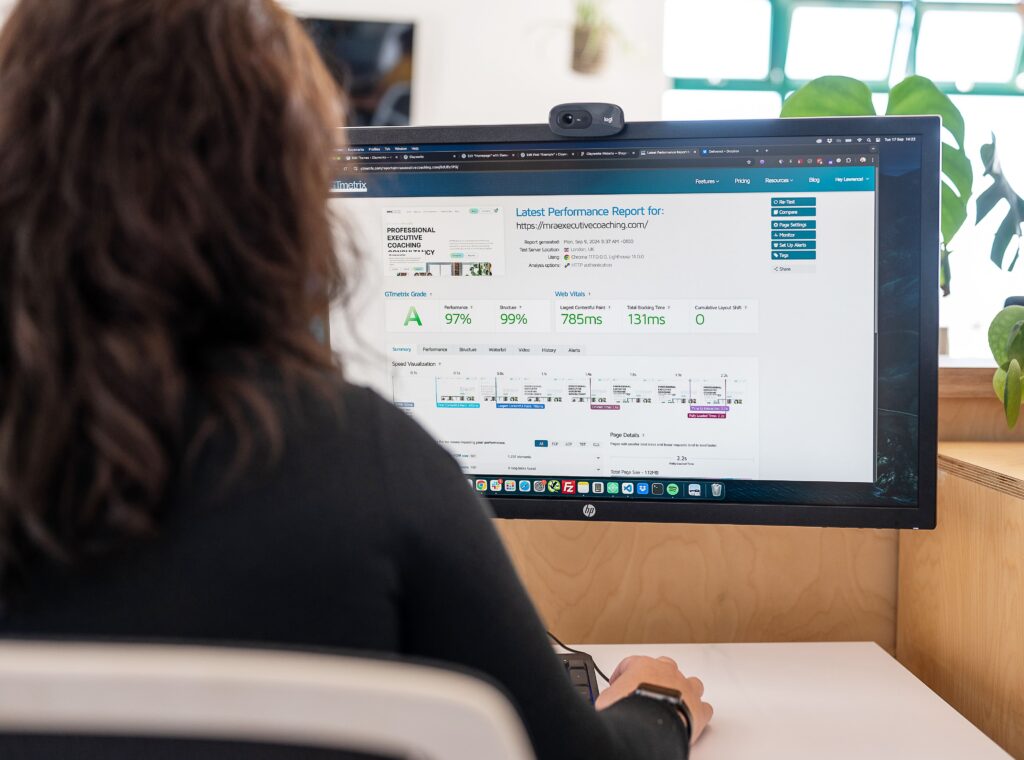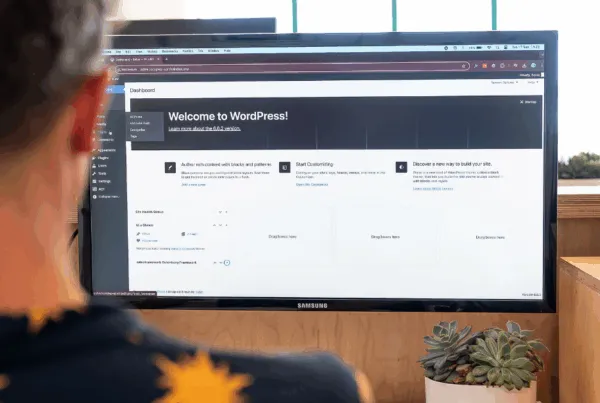
It’s often said in the web design world that you have just three seconds to make an impression on visitors. If people can’t grasp your brand’s purpose and value within this crucial window, they’ll bounce and head straight to the next website in the search results.
If it’s been a few years since you last gave your website a critical eye, it might not be keeping up with your target audience’s expectations or your business goals. Knowing when to redesign your website is about more than improving aesthetics; it’s about enhancing performance, usability, and credibility. A redesign can transform how customers see your brand, boost conversions, and make updates easier for your team. But how do you know when it’s time?
As a multi-award-winning SEO and web design company, here at Solve, we’ve been guiding clients through successful website redesigns for over 20 years, with measurable results that drive real growth. In this blog, we’ll explore eight telltale signs that a redesign should be on your radar, and how to get the process started.
When to Redesign Your Website
Why Knowing When to Redesign Your Website Matters
Your website isn’t a one-time project – you can’t just hit ‘live’ and forget about it. It’s an evolving tool for your business. Over time, technology advances, design trends shift, and customer expectations rise. A site that once worked perfectly can slowly become outdated, harder to use, or misaligned with your goals.
Recognising when to redesign your website helps you stay ahead of those changes. It ensures your site continues to attract the right visitors, build trust, and convert interest into action.
Ignoring the signs can lead to declining traffic, lower search visibility, and ultimately, missed opportunities.
How Often Should You Redesign Your Website?
Most businesses benefit from a redesign every three to five years, depending on your industry and how fast digital trends move around you. If your competitors’ sites are smoother, faster, or more engaging than yours, that’s often a clear signal that it’s time to act.
That doesn’t mean you need a complete overhaul every few years. Sometimes a strategic refresh, like updating visuals, improving user experience (UX), or refreshing content, can make a big impact. The key is to keep monitoring your site’s performance and be ready to adapt when your data or your customers tell you it’s time.

1. Your Website Design Isn’t Keeping Up
First Impressions and Modern Design Standards
Your website is your digital shopfront, and visitors can spot a dated design instantly. Fonts, colours, layouts, and imagery all signal whether your business feels modern, trustworthy, and relevant. If your site doesn’t keep up with current design standards, it can quickly affect how people perceive your credibility. An older site can make even the most forward-thinking business seem behind the curve.
Clean layouts, bold typography, and intuitive navigation are now the baseline. Visitors expect a site that feels effortless to use, with fast-loading pages, crisp visuals, and a responsive design that adapts seamlessly to any device.
The 3-Second Rule in Web Design: Why Speed & Visuals Matter
The three-second rule in web design says you have just seconds to capture attention and communicate value. In that short time, visitors decide whether your site looks credible and whether it’s worth staying.
A homepage with strong visuals that loads quickly and clearly shows who you are and what you do is essential. If your site takes too long to load or fails to make an instant impact, people will simply move on.
And the faster your website loads, the better your chances of converting visitors to buyers. Studies show that conversions are three times higher for sites that load in one second compared to those that take five.
Use tools like Google PageSpeed Insights or GTmetrix to test your load times. Anything over three seconds risks losing valuable traffic.
The 7 Cs of a Website: Are You Missing Any?
A strong website should balance seven key elements.
- Clarity – Is your message clear within seconds?
- Consistency – Do your colours, fonts, and imagery align with your brand?
- Compatibility – Does your site work smoothly across devices?
- Credibility – Do you look professional and trustworthy?
- Content – Is your information relevant, engaging and up to date?
- Conversion – Are visitors guided naturally to take action?
- Creativity – Does your design stand out for the right reasons?
A modern redesign can help you check all seven boxes, ensuring your site feels fresh, credible and aligned with your business today.
2. Poor User Experience (UX)
Signs Your UX Is Failing Your Visitors
Visitors should be able to find what they need quickly and easily. If they can’t, they’ll leave. Common UX warning signs include:
- High bounce rates or short average session durations
- Low engagement on key pages
- Confusing menus or cluttered layouts
- Calls to action that aren’t clear or visible enough
If customers frequently call or message to ask where to find something on your website, that’s a clear sign your UX needs attention.

Mobile Responsiveness and Navigation Best Practices
Around 60 per cent of web traffic now comes from mobile devices. If your site doesn’t adapt seamlessly to different screen sizes, you’re losing potential customers. Mobile visitors expect quick loading times, clean menus, and layouts that make scrolling and tapping easy.
Navigation should also be simple and intuitive. Limit menu options, keep key links visible across pages, and avoid unnecessary clicks between important information. When in doubt, test your site on multiple devices and ask real users for feedback.
Website Redesign Tips for Better User Flow
Improving UX often comes down to removing barriers. Streamline the path between landing on your site and taking action, whether that’s filling out a form, booking a service, or making a purchase.
Here are a few practical website redesign tips:
- Simplify navigation and reduce visual clutter.
- Use consistent buttons and visual cues for actions.
- Break up long text with visuals, headings, and white space.
- Ensure every page has a clear purpose and next step.
When users can move through your website easily, they’ll stay longer, engage more, and be far more likely to convert.
3. Your Website Is Not Converting
Declining Leads or Sales: What It Could Mean
A fall in conversion rate often signals that your website isn’t meeting user expectations. Visitors might not understand what you offer, where to click, or why they should trust you. If your calls to action are unclear, your pages take too long to load, or your checkout or enquiry process feels complicated, people will just give up before completing their journey.
Even subtle issues can have a big impact. For example, a misplaced button or confusing copy can disrupt the flow. A redesign can help you refocus your messaging and layout so users are guided naturally from interest to action.
Heatmaps and Analytics for Redesign Decisions
Before jumping into a redesign, take time to analyse how visitors actually behave on your site. Tools such as Google Analytics can show you what’s working and what’s not. Heatmaps reveal which sections attract attention, while scroll tracking shows how far people get before leaving. Session recordings can even uncover frustrating points in your user journey that you might not notice otherwise.
These insights allow you to base your redesign on real behaviour rather than assumptions, helping you focus on the changes that will genuinely boost engagement and conversions.
Things to Consider When Redesigning a Website for Conversions
When conversion is your goal, every design choice should lead users closer to taking action, whether it’s clicking ‘buy now’ or filling out a contact form. Prioritise clarity, trust, and ease of use. Make sure each page communicates your value clearly, with strong calls to action that stand out visually and contextually.
Build trust through consistent branding, real testimonials, and recognisable logos or certifications. Keep forms short and frictionless, and streamline the checkout or enquiry process so there are no unnecessary steps. When your website feels intuitive and trustworthy, visitors are far more likely to become customers.

4. Simple Updates Are A Struggle
Is Your CMS Holding You Back?
Many older websites are built on clunky content management systems (CMS) that make updates and maintenance time-consuming or overly technical. If you rely on a developer for every small tweak, your CMS might be limiting your flexibility and adding unnecessary costs.
A modern CMS should make it easy to update copy, swap images, and publish new posts without coding knowledge. If it doesn’t, you’re likely missing opportunities to keep your website fresh and responsive to your business needs.
Streamlining Updates with a Modern CMS
Platforms like WordPress or Shopify offer intuitive tools for editing, optimising, and managing content. With the right setup from your web designer, your team can make updates in minutes rather than days. And that agility can make all the difference, whether you’re launching a new product, changing your pricing, or publishing a blog.
A professional redesign can give you a system that’s both scalable and easy to maintain. You can also integrate new features such as drag-and-drop editing, SEO plugins, and automated backups to reduce future workload.
Website Update Checklist: What to Fix First
When planning your redesign, start with the areas that cause the most friction. This checklist can help you prioritise:
- Update frequency – How often do you need to make changes, and who’s responsible?
- Outdated plugins – Identify anything that’s no longer supported or slowing your site down.
- Broken integrations – Check connections to your CRM, booking tools, or analytics platforms.
- Security and backups – Make sure your CMS is protected and has reliable restore points.
- Performance issues – Look for slow pages or technical errors that frustrate users.
- Scalability – Ensure your setup can grow with your business and handle new functionality.
Addressing these areas first will make your new site easier to maintain and much more sustainable long term.
5. Your Branding Has Changed
Aligning Visuals, Messaging, and Mission
Your website is the digital face of your brand, so colour palette, logos, and copy need to match your current identity. If your branding has changed, a redesign helps you bring everything back into alignment, from imagery and tone of voice to fonts and layout.
And it’s not just about updating visuals, you need to ensure your mission, values, and brand personality come through consistently in every element of your online presence, which builds trust and recognition.
Matching Your Brand Evolution
Over time, your audience may change. You might have expanded your services, repositioned your brand, or refined your target market – all of which should be reflected on your website. If the people you want to reach don’t immediately see themselves in your messaging, it’s time to adjust.
A fresh design gives you the chance to express your brand more clearly and confidently. It ensures visitors recognise who you are and understand why your business is the right choice for them.
6. Your Website Is Underperforming in Search
Key SEO Metrics That Signal It’s Time to Redesign
Falling organic traffic, lower keyword rankings, and fewer enquiries from search are all signs your site may be underperforming. Slow load times, broken links, and outdated code can make it harder for search engines to crawl and index your pages effectively.
User engagement metrics also play a role. High bounce rates, short session durations, or low click-through rates from search results can all signal poor relevance or usability, both of which are important ranking factors.

Redesigning with SEO in Mind: Best Practices
A website redesign is the ideal opportunity to strengthen your SEO foundations. By partnering with an agency that specialises in both web design and SEO – like we do here at Solve – you’ll get a site that not only looks great but performs brilliantly in search.
Our process starts with a full review of your existing site to identify what’s working, what isn’t, and where improvements can be made. From there, we plan a new structure, layout, and content strategy designed to maximise visibility and performance. That includes implementing up-to-date SEO best practices such as fast load speeds, mobile-friendly design, clear navigation, and optimised metadata. Redirects, internal linking, and content optimisation are all handled carefully to protect your search engine rankings and enhance usability.
By combining technical SEO with a seamless user experience, your redesigned website will perform better in search and turn more of your website traffic into customers.
7. Your Site Is Not Aligned with Business Goals
Scaling Your Website Alongside Your Business
As your business grows, your website needs to scale with it. Maybe you’ve expanded into new markets or launched additional services. If your site hasn’t adapted, it may no longer communicate your value effectively.
A redesign ensures your website’s structure, messaging, and functionality reflect where your business is headed. That could mean adding new service pages, optimising for different audiences and keywords, or integrating tools that support your internal processes and customer journey.
Lead Generation, E-commerce, and Content Strategy Considerations
Whether you want to generate more enquiries, boost e-commerce sales, or strengthen your content marketing, your website should be designed around these goals. If you’re seeing traffic but not results, chances are your site isn’t aligned with your conversion funnel.
A strategic redesign helps you put the right systems in place, from clear calls to action and conversion tracking to streamlined checkout experiences and integrated marketing tools. You need a website that actively supports your business strategy rather than simply sitting alongside it.
When to Redesign Your Website for Business Growth
A new website shouldn’t just keep up with your business – it should help drive what comes next. When designed strategically, it becomes a platform for innovation, helping you reach new audiences, reduce your digital footprint, and grow with confidence.
At Solve, we go beyond design to deliver a complete growth solution. By combining web design, SEO, strategy, and green hosting, we create websites that actively support your long-term ambitions and help your business move forward.

8. Your Website No Longer Reflects Your Content Strategy
How Content Shapes Website Performance
Your content is one of your most powerful marketing tools, but only if your website supports it. If publishing blogs, updating landing pages, or embedding videos feels like hard work, your site may not be built to handle your current strategy. A well-designed website should make it simple to share valuable content and optimise it for SEO.
Aligning Design and Content Goals
Your website’s structure, layout, and navigation should guide visitors naturally toward your most important content. If your best blogs, case studies, or resources are buried or hard to find, your design is limiting their impact. A redesign can help you bring your content strategy to life, showcasing what matters most and turning your expertise into real business growth. For example, featuring blog highlights, recent case studies, or social previews on your homepage can help bring your content centre stage.
Planning Your Website Redesign: What Comes Next
Once you’ve recognised the signs that it’s time to redesign your website, the next step is planning how to do it effectively.
Website Redesign Tips for a Smooth Transition
Whether you are planning a redesign yourself or working with an expert agency, a little planning goes a long way in ensuring a smooth website redesign. Here are a few key steps to keep things on track:
- Set clear goals – Define what success looks like, whether that’s more leads, better SEO performance, or improved user experience.
- Audit your current website – Identify what’s working, what isn’t, and which pages drive the most value.
- Plan your content early – Decide which pages to keep, update, or retire to maintain clarity and consistency.
- Preserve your SEO – Use redirects, check metadata, and monitor performance after launch to protect your rankings.
- Choose the right partner – Work with an agency that understands both design and SEO, ensuring every element of your new site is built to perform.
By approaching your redesign strategically, you’ll avoid common pitfalls and ensure your new website is stronger, faster, and better aligned with your goals from day one.
Ready for a Website Refresh?
If you’ve spotted some of these telltale signs on your own website, it might be time for a redesign. At Solve, we combine expert web design, SEO, content, and fast, green hosting to create websites that look exceptional and deliver measurable results.
Whether you’re ready for a full redesign or simply want to explore your options, we’ll help you build a site that grows with your business and gets you seen online.





